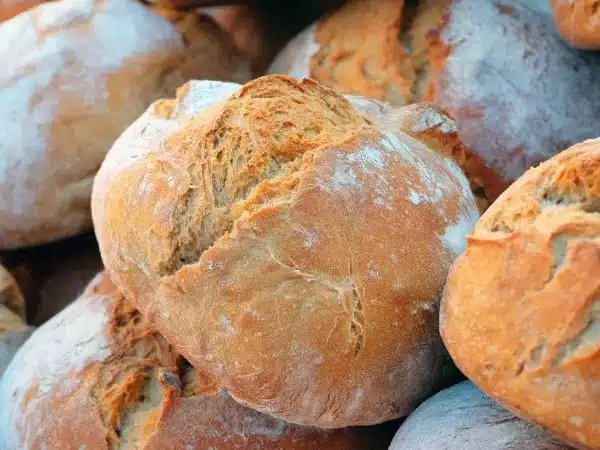There’s nothing quite like the aroma of freshly baked bread, and it can be hard to resist the temptation to slice into that warm loaf. However, experienced bakers emphasize one crucial step: allowing the bread to cool before slicing.
So, let’s explore the reasons why bread needs to cool before it can be sliced and understand why cooling is an essential part of the bread-baking process.
The cooling process of bread is essential for several reasons: • It allows the bread to set and stabilize its internal structure, resulting in clean and even slices. • It enables the moisture within the bread to redistribute, evaporate, and create a crisp crust. • It contributes to flavor development in the bread. Slicing bread prematurely before it has completely cooled can result in the loss of moisture and steam, leading to a denser and drier interior. Additionally, it can potentially compress the bread's still gummy crumb structure.

What Happens During the Cooling Process of Bread?
The cooling process, marking the final stage in the 12-step bread-making journey, offers several benefits that enhance the texture, flavor, and aesthetic appearance of bread.
1. Proper crumb texture
During baking, the heat causes the starch granules in the flour to absorb water and swell, forming a gel-like structure. As the bread cools, the gelatinized starch molecules start to reorganize and form intermolecular bonds, resulting in a more rigid and structured crumb. This process is known as starch retrogradation, and it plays a crucial role in maintaining the shape of the loaf.
Furthermore, during the cooling stage, the proteins in the bread continue to set, contributing to the formation and stabilization of the crumb structure. The proteins, particularly gluten, undergo a process called coagulation, where they denature and solidify. This coagulation helps the bread retain its shape and structure.
2. Moisture redistribution
During the baking process, the heat of the oven causes the water in the dough to turn into steam. This steam contributes to oven spring, the rapid rise of the dough in the early stages of baking. After the bread is removed from the oven and begins to cool, moisture redistribution continues.
While the bread is hot, the steam produced during baking is trapped within the loaf. Cooling allows the moisture within the bread to redistribute evenly throughout the loaf. This moisture redistribution helps maintain a balanced moisture content throughout the bread, reducing the chances of it becoming overly dry or soggy.
3. Flavor development
The cooling process significantly contributes to the development of flavor in the bread, as the chemical reactions that occur during baking continue at a slower pace.
As the bread cools, the flavors within the loaf have an opportunity to diffuse and distribute more evenly throughout the crumb. The volatile compounds responsible for the aroma and taste of bread are released during the baking process. During cooling, these compounds disperse, allowing the flavors to meld together, resulting in a more optimal and developed flavor profile.
Similar to many other food products, bread benefits from a period of maturation after baking. After the bread has cooled, it continues to undergo subtle chemical changes, allowing the flavors to further develop and mature over time. The length of this maturation period can vary from a couple of hours to a day or more, depending on the specific recipe and desired flavor profile. For sourdough or rye bread, it can take 24-48 hours.
4. Clean and even slicing
When the bread is fresh out of the oven, it tends to have a softer and gummy crumb structure. Slicing the bread while it is still hot or warm can result in squashed or compressed slices, making it challenging to achieve clean and even cuts.
As the bread cools, its crumb structure continues to develop and solidify. A firmer loaf is easier to handle and slice neatly, resulting in slices that maintain their shape.
Consequences of Cutting Bread Prematurely
Cutting bread prematurely can have several negative consequences. When the bread is warm, it is more prone to distortion and uneven slicing due to its softer state. Prematurely cutting into warm bread can result in compressed and squashed slices, as well as a crumb that tends to tear or crumble.
In addition, cutting into warm bread releases trapped moisture, which is crucial for maintaining freshness. When the bread is cut too soon, the moisture escapes more rapidly, causing the crumb to dry out faster.
Furthermore, cutting into warm bread before it has had a chance to cool deprives the flavors of important development time. Allowing the bread to cool properly helps the flavors to fully develop and enhance the overall taste.

How to Cool and Store Bread Properly?
When the bread comes out of the oven, it continues to emit steam due to its high internal temperature. If the bread is cut or packaged immediately, the trapped steam has nowhere to escape, leading to condensation and moisture accumulation within the loaf.
To ensure the safety and quality of the bread, it is important to cool it to an appropriate temperature before storage. If the trapped steam condenses, it can create a moist environment, resulting in a soggy crust and a shorter shelf life. Moreover, moisture provides an ideal breeding ground for harmful bacteria and mold, increasing the risk of spoilage and foodborne illnesses.
While the bread is cooling, avoid covering it with a towel, plastic wrap, or any other covering. This prevents moisture from getting trapped and causing a soggy crust. Instead, allow for air circulation to maintain a nice and crunchy crust. A cooling rack is useful for this purpose.
Once the bread has cooled completely, store it in a breathable bag such as a linen or paper bag. Avoid using a plastic bag at this stage as it can trap moisture. The breathable bag will help prevent the bread from drying out while allowing some airflow. Bread should not be kept in the fridge because the cool temperature accelerates the starch retrogradation process, making it stale faster.
If you need to store the bread for a few days, you can place the bread wrapped in linen or a paper bag inside a partially open plastic bag. This combination allows for some air circulation while still providing a protective barrier.
If you need to store the bread for an extended period, freezing is the best solution. Slice the bread before freezing and place parchment paper or wax paper between the slices to prevent them from sticking together. Then, tightly wrap the sliced bread in plastic wrap or place it in a sealed freezer bag. Frozen bread can last for several months.
Reheat as needed: When you’re ready to eat the frozen bread, you can defrost it at room temperature or reheat it in an oven or toaster. Only thaw or heat the amount of bread you intend to consume to avoid unnecessary waste.
Remember, stale or slightly dried bread can still be repurposed. You can use it to make bread puddings, breadcrumbs, croutons, or simply toast it for a crunchy texture. Properly cooling and storing bread not only extends its usability but also helps reduce food waste.
Final Thoughts
In conclusion, the cooling process provides several benefits, including proper crumb texture, moisture redistribution, flavor development, and clean and even slicing. Cooling allows the bread’s internal structure to set and stabilize, creating a more structured and appealing crumb.
While it may require patience to wait for the bread to cool completely, the improved texture and flavor are worth the wait, resulting in a more enjoyable eating experience.

